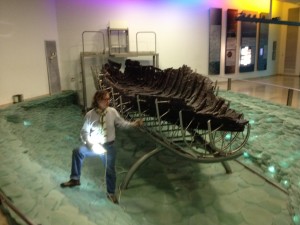Every private tour guide in Israel has their favorite sites. I call them “must do’s.” Here is one of them: This is the ancient boat on Kibbutz Ginnosar on the Sea of Galilee in Israel.
The Sea of Galilee is not a sea, but a slightly brackish fresh-water lake, called Lake Kinneret today, but 2,000 years ago, the western and northern side of the lake and the surrounding rich farmland provided a livelihood for Jewish residents here. Among them was a rabbi well known in the area as a healer, teacher and holy man. His name was Yeshua of Natzrat: Jesus of Nazareth.
In 1986, a remarkable discovery was made by two Jewish residents of Kibbutz Ginosar, a collective Israeli farm community which is situated today on the same site as ancient Geneseret, a Jewish village well known to Jesus.
While strolling alone the shore one morning, the two brothers saw something buried in the mud, the result of low waters levels from a drought that year.
That something was a 2,000 year-old boat. A fishing boat twenty-seven feet long and seven feet wide, the shallow bottom well suited to ply the waters of the lake. We do not know if Jesus was in this particular boat, but it does match the type Jesus and his disciples would have used to fish and preach from on the waters of Galilee.
As far as I know, this is the oldest original maritime vessel on display on any museum in the world.
However, the boat’s attraction is not only its age, but the feelings aroused when seen. Jews, as well as Christian visitors look at awe upon this find. We must remember that the rustic villagers who lived on this side of the lake were Jews, eking out a very precarious existence until Roman rule.
Pictured with the boat is Professor Jerome Hall of San Diego University, who will be publishing the final report on the vessel in the near future.
I invite you to come to Israel to the Yigal Allon Museum and visit this spectacular archaeological find.


